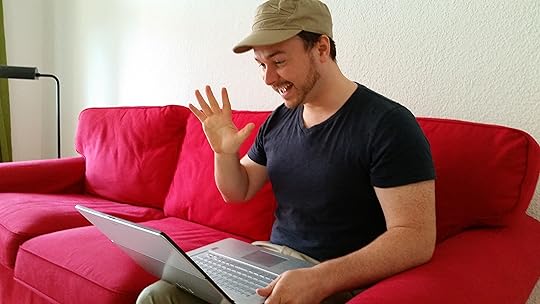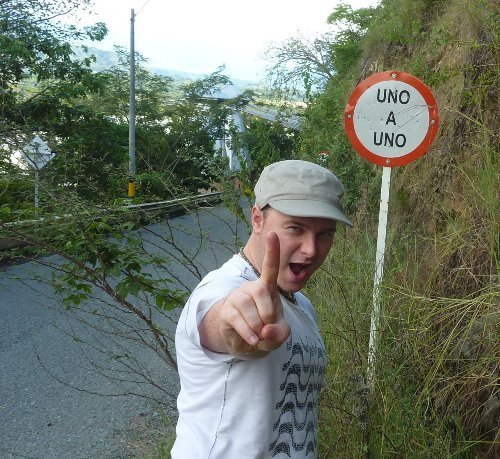Benny Lewis's Blog, page 91
March 3, 2015
A Year Without Speaking English
I’m extremely proud to share this guest post by my friend Scott Young, who challenged himself to spend a year learning four new languages through total immersion along with his friend Vat. Their rule for the year: no English. Scott and Vat’s story is truly inspirational, and the video footage they took of their journey is breathtaking. Over to you, Scott.
How fast could you learn a language… if you totally avoided speaking English?
How difficult would it be to live completely outside your native tongue, starting with just the basics of a brand new language?
Could you become reasonably fluent in just three months?
There are the questions my friend Vat and I set out to explore in our recent year-long trip around the world.
ONE YEAR WITHOUT ENGLISH: 4 LANGUAGES IN 365 DAYS
Vat and I went to four countries – Spain, Brazil, China and Korea – chosen for geographic diversity and personal interest. We spent 3 months in each country, aiming to learn as much as possible of the local language by following one simple rule: don’t speak English.
How well did we do?
Here’s a brief, unscripted video you can see of us speaking in all four languages, so you can judge for yourself.
//www.youtube.com/watch?v=vPnHJ1OoK5o
A 3-minute, informal conversation isn’t a very good test, though. So I’ll also show you more in-depth footage of how we tackled our missions in Spanish,Portuguese, Mandarin Chinese, and Korean.
The short answer is that because we had no choice but to dive into each language, we learned a lot in all 4 languages. But did we become fluent?
The only exam I took to measure by ability was China’s official exam for testing fluency in Mandarin Chinese (the HSK 4), which I passed with a 74%. The creators of the exam state an official correspondence with this and a B2 level, however that’s not without some controversy.
For the other languages, I’ll have to use more of an informal assessment.
My rough estimate is that we reached upper intermediate level in Spanish, and intermediate Portuguese. Vat’s Chinese was somewhat worse than mine, probably reaching a lower-intermediate level. However my Korean was somewhat worse than his, with him reaching an intermediate, and me reaching a lower-intermediate level. (This wasn’t too surprising, since Vat was excited to learn Korean from the start of our trip, whereas I’d gotten really into Chinese. Motive matters).
This means that in Spanish, we’re functionally fluent. We make grammatical mistakes and have an accent, but we can easily have long conversations with strangers about any topic, without a dictionary. Portuguese a little less so, although still conversational. Chinese and Korean are difficult to compare to European languages, since they don’t follow the same difficulty curve, but we were both comfortable using the languages for daily life.
LESSONS I LEARNED FROM SPEAKING NO ENGLISH
The four languages of this trip weren’t my first time learning a foreign language. That was French. I had spent a year studying in France as part of my university course.
Like Spanish, Portuguese, Chinese and Korean, I had only minimal practice in French and wanted to become fluent during my stay. But unlike my recent languages, I didn’t throw myself into the language with no English. I worked hard and I studied hard, and I left with an intermediate level of French. But unfortunately it was often painfully difficult. Even six months after I started, holding a long conversation was exhausting.
Contrast that with Spanish, where Vat (who had no prior experience with Romance languages) and I both outdid a year of living and studying in French in just three months. I couldn’t believe that it was possible to learn a language four times as fast, especially since my time learning French was strenuous and didn’t feel particularly slow.
Today I want to share the methods we used that led to such a huge difference in efficiency and effort. Hopefully you can apply them to speed up your own learning tasks.
Spain: Why Opting for Zero English Actually Makes Learning Easier
//www.youtube.com/watch?v=3oPIDXKf-Bw
Spain was the first country in our journey. We were nervous about the no-English rule. After all, what if it simply proved too difficult? What if our idea to limit English for a year was actually a vow of silence, if learning a language in three months was beyond our abilities?
Because of this pressure, Vat and I were extremely strict about not speaking English. We permitted some necessary calls to family back home, or English in emergencies, but otherwise we spoke only in Spanish to anyone we met, including each other.
Sometimes this had funny consequences. Benny happened to be living in Valencia, Spain at the same time we were doing our Spanish project. Benny speaks fluent Spanish, but unfortunately his partner Lauren does not. That meant Benny ended up translating for us back to English whenever the four of us would hang out.
From the outside, this sounds painfully difficult. Heck, even looking back I’m amazed we were able to be so stubbornly consistent about applying the rule in Spain.
From the inside, however, it was a different story. The first two weeks were hard, especially on Vat, who didn’t have as much prior practice. But after that initial grind things got a lot easier. So much easier that by the middle of the second month we didn’t even think about it. We were learning intensely, but life itself was fairly relaxed.
If there’s one lesson from our trip it’s this: going no-English is hard in the beginning, but it quickly becomes much less strenuous than learning a language by any other method. Putting up with an intense first month allowed me to quadruple my previous progress in French, where I was also working hard at the language and living in France.
Brazil: Immersion Trumps Studying
//www.youtube.com/watch?v=UqavSdojM4E
Our experience learning Portuguese in Brazil was a lot bumpier than in Spain. For one, our practice was extremely limited. When we arrived, I had done four hours learning some very basic expressions and Vat hadn’t done any.
On top of this, we had some temporary problems upon arrival. Our prebooked apartment was a nightmare, so after cancelling the rent, we were temporarily homeless. Finding a new apartment was difficult since nobody spoke English or Spanish and everything had been booked for the holidays. Language learning was no longer a fun excursion; it was necessary for survival.
We wandered up and down the small village we lived in, with a pre-memorized phrase saying “We’re looking for an apartment for two months.” After several days and dozens of rejections, we finally found someone who might be able to rent us a place that was supposed to be for sale. This led to an interesting experience seeing the Brazilian bureaucracy at work, with lawyers being brought in, contracts being signed, fingerprints taken and family histories written down. Perhaps a little excessive for two months of pre-paid rent.
Despite that rocky start, we both picked up on the Portuguese quickly and in less than a month we were back to our normal lives. Neither of us studied very much, preferring to learn while taking surfing lessons or at the local samba bar. Vat was even working full-time on his portfolio for architecture school most of the trip, and it didn’t slow him down.
Studying is great, but it doesn’t substitute for immersion. If you can’t get the immersion of living in the country, you can at least try to avoid your native language during Skype lessons, or go to meetups where you only speak the target language. You’ll be amazed at what a difference it makes to the speed of your progress.
Click to tweet: “Studying a language is great, but it’s no substitute for full immersion.”
China and Taiwan: The Importance of Laying a Foundation
//www.youtube.com/watch?v=6UFU_i5KWAQ
China was beautiful, fascinating and probably my favorite country. But it was also fiendishly difficult.
I know Benny doesn’t like to dwell on the assumed “difficulty” of languages. That’s an attitude that can trap you into thinking learning or immersion is impossible. I completely agree.
However, I think the difficulty of Chinese relative to Spanish or Portuguese was also very useful in reshaping our learning methods. While immersion with limited studying was more than enough in Spain and Brazil, in China this method started to show some defects.
For one, the entry barrier to communication in China is higher. The phonology is difficult, so people often don’t understand you, even when you believe you’re speaking correctly. Second, it has few cognates with English, so you must learn an entirely new pantheon of linguistic concepts and connections.
My solution was to spend more time building a foundation. Practice tone drills until you can produce them reliably. Learn to associate syllables to fundamental concepts, so you can recognize them when they’re built into compound words. I even chose to learn the characters, to help solidify this association between fundamental concepts and the words I chose to learn.
Chinese was a lot more work than Spanish or Portuguese. But it was also more rewarding. Unlike European languages which often link to similar religions, cultures, values and ways of conceptualizing the world, Chinese stands alone. So each conversation, while hard-won, was also a link to a completely different history and culture.
Chinese also becomes progressively easier to learn the larger your foundation. Originally, Vat and I found it much harder to learn new Chinese words than when we were first learning Spanish. Near the end, however, we knew enough of the building blocks so new words could be linked back to old concepts: panda is a “bear cat”, pumpkin is a “south melon”, wine is “grape alcohol”.
I had prepared more than Vat with Chinese, so I was able to shift into the no-English rule easier than he did. I still found it incredibly useful, but I also believe it takes more foundational work for it to be successful.
Korea: Don’t Let Other Language Learners Hold You Back
//www.youtube.com/watch?v=78BYEKr97TM
During our travels, we met a lot of foreigners who wanted to learn the local language, but weren’t making the progress they desired. Nowhere was this more abundant than in Korea.
While in Korea, the majority of Westerners we met couldn’t speak more than a handful of Korean sentences. Some had lived there for decades and still hadn’t reached a level where they could hold a basic conversation.
There are some reasons for this: many people go to Korea to teach English, and never fully form a plan for learning Korean. The English level of young people is quite good. Like Chinese, it doesn’t share any linguistic roots with European languages and it has some tricky pieces of phonology and grammar.
However, valid as these reasons may be, they almost created a cult of Korean impossibility. Everyone we spoke to complained about how difficult it was to make any progress in learning Korean.
Vat and I, at this point on our trip, were pretty exhausted. Nearly a year of travel and having repeated the language-learning immersion process three times in a row, we were hardly in our best shape. We had broken the no-English rule a number of times, and we were feeling guilty about not holding to the principles of our project.
Still, I managed to reach a working level of Korean in three months, with Vat’s improving even faster than mine. Korea was difficult for us personally, after a year of travel, but it certainly didn’t meet the standards of impossibility that many of our acquaintances complained about.
What I learned in Korea was that sometimes a language is difficult to learn, not because of difficulty, but because everybody is afraid to try. If you surround yourself with people who never really attempt to immerse themselves, the odds of success appear artificially low.
What’s Next?
Unlike Benny, Vat and I didn’t intend our trip to become a permanent lifestyle. We wanted to take a gap year to explore and then return to our normal lives. Vat has gone back to study architecture and I’ve returned to writing in Canada.
That said, we don’t plan on giving up the language learning progress. Three months may be an interesting experiment, but the goal isn’t intermediacy—it’s fluency.
In the five months since we’ve returned, I’ve maintained a fairly consistent schedule of weekly conversation practice with each of the languages. I’ve focused more on Chinese lately, by finishing learning the first 2500 characters. I now plan to begin practicing handwriting and reading real books and articles. I also got to spend two weeks in Mexico recently, improving my Spanish.
The real advantage of the short-term immersion project, in my mind, was that it helped us both get over the frustration barrier of learning a new language. When you can’t do anything, practicing a language is frustrating. When you can have conversations, even basic ones, it’s fun.
How You Can Use No-English in Your Language Learning Missions
Maybe you’re not quite ready to embark on a year without your native language, and that’s okay. But there are still simpler (and cheaper) ways you can apply this advice into your own language-learning project to get past that frustration barrier and start enjoying it.
Go no-English with a partner or roommate. Most of our learning came from communicating with each other. So you could get a lot of the same benefit just by committing to chatting to the people you live with, in your target language. Here’s an interesting video of two friends who did that with Spanish.
Take a month of immersion in a country. Three months is a completely arbitrary time period. A month, or even two weeks, can still accelerate your learning. This is particular the case if it’s a language you’ve already studied for some time. With these languages, going no-English for even as little as a week can cause rapid growth. You may even discover that you’re close to fluent than you imagined.
Set your first no-English tutoring session. I don’t agree that going no-English for tutoring is always the best idea (you may not be able to ask the questions you need to, in order to learn how the language works). But even if you don’t always go no-English, having chunks of time for conversation practice is something you can start from the very first day.
Click to tweet: “A month, or even two weeks living abroad, can rapidly accelerate your learning.”
Languages are a window to different cultures, people and ways of thinking. Unfortunately, it’s a window that’s often unnecessarily locked behind years of studying or false beliefs about what you can learn.
I hope my project shows you that the window is much more open than it first appears.
Scott Young is an entrepreneur, writer, and the author of Learn More, Study Less. Click here to get a copy of his rapid-learning ebook, explaining how you can learn anything faster.
The post A Year Without Speaking English appeared first on Fluent in 3 months - Language Hacking and Travel Tips.




February 27, 2015
“I’ll Do It Tomorrow” – Solving 3 Mindtraps that Make You Put Off Language Learning
You just spent a few hours studying your target language, and you’re feeling great. You’re feeling like you can do this. You’ve got a routine planned. You’ve got it all mapped out.
But a day goes by. Then two days. And you haven’t gotten back to your language practice.
Before you know it, you start beating yourself up. Guilt sets in.
After three or four days, your language learner’s guilt is in full swing, and you feel so bad about it that you actually start avoiding language learning the same way you’d avoid a friend whose text you never answered or whose birthday you forgot.
You’ve halted your language progress not because you’re genuinely too busy. You feel guilty about breaking the promise to yourself that this time you wouldn’t give up. You’ve only got to think about the learning you should have done, and shame hangs over you like a murky cloud.
It’s so much easier to pretend like the problem isn’t there than it is to figure out a way to solve it for the long term.
But you can solve this problem by recognizing the top 3 mind traps that will paralyse your language learning progress.
Mindtrap #1: You think the key to success is creating a bulletproof learning schedule.

In language learning, it’s great to create a schedule to organize your time. But in planning out a schedule, you have to simultaneously know beyond the shadow of a doubt that you will at some point get off track and be behind on your plans.
I’m going to let you in on a secret.
Many, many people who start with the plan to learn a new language never achieve their goal.
And do you want to know why?
It’s not because they’re too busy. And it’s not because they’re not smart enough.
It’s because at some point, they stopped regularly practising their language and then they never started it up again.
This may seem like a sad fact, but if you think about that for a moment, it actually reveals a pretty empowering truth.
Even the best laid plans sometimes just don’t work out. And most of the time language-learning schedules are more optimistic than they are realistic.
If you want to be the exception to this fate, if you want to succeed in learning Spanish, German, Chinese, whichever. You don’t need to be the person who never breaks your schedule. You just need to not be the person who never picks it up again.
And that’s it.
You don’t have to avoid getting off track – that’s the beauty here. In fact, you should expect to get off track. More than once. It may even be a regular thing, and that’s okay.
All language learners get off schedule. All language learners skip a day or three or sometimes thirteen. I’ve done it more times than I can count. This absolutely does not have to be the end. The trick is to not let the guilt make you feel like things are over. It isn’t over until you stop. And you get to decide when that happens.
So go ahead and pick up that Teach Yourself book you hid behind the couch because it was staring at you. And send a new session request to the italki teacher you cancelled on two sessions in a row. Just suck up your pride and do it. It’s time to get back on track.
Mindtrap #2: You try to fix a broken routine by “making up” for lost time
“How can I make up for that lost time?” Is this your first response when you’re behind on the best laid language plans, or when you’ve missed your last few language classes?
This is dangerous territory.
If you’re only behind by an hour or two, then sure, this kind of thinking is no problem, and you should share with me your secrets, you wizard!
But if you’re mortal, it’s much more likely that you started off your project thinking you could pack way more hours of study time into a day – every day – than turned out to actually be realistic. I remember my own first attempt to learn Spanish, and how it began with me thinking that if I read a certain amount of pages of el señor de los anillos in Spanish each day, then I’d be fluent in no time.
Here’s how this sort of dangerous and faulty logic starts to ruin your progress. You think to yourself,
“I’m supposed to be studying 6 hours a day, and I missed all of last week, which makes me 42 hours behind… so I guess I can make it up if I add in 2 hours a day for the next 3 weeks…”
It doesn’t take Alan Turing to see how things can get bad from there…
Don’t try to “fix” a set of already-difficult-to-meet goals by adding to the list!
The problem with this thought process is that the entire time you’re trying to “make up for lost time”, you feel like an utter failure. You’re behind. And every day you’re counting exactly how many hours behind you are. And until you (somehow, magically) do make up those hours, you’ll feel behind, and you’ll feel like your failure, and that’s just no fun at all. Is that how you want to feel when you look ahead at your language-learning calendar?
So don’t think about all the hours you were supposed to have studied but didn’t. Mathematical masochism helps no one.
Instead, just get back into the rhythm of the schedule you originally set yourself. And if that proves too difficult, you might be falling into the next mindtrap…
Mindtrap #3: You don’t value “study minutes” as much as you do “study hours”

Back when I first started language learning, I counted my study time in hours. The more hours I could do in a day, the better. I got a lot done. But I also wasted a lot of time. When I only had a few minutes to spare, I wasted them surfing online, watching TV or refreshing my email inbox for the seventh time instead of investing them into my language project.
You’ve probably heard the phrase: “Look after the pennies, and the dollars will look after themselves.” The same is true of language learning.
If you’re suffering from guilt or stress about how behind you are on your study hours, then maybe you should stop counting how many hours you’re practising for a few days, and instead see how many more minutes you can squeeze into a day.
Perhaps you literally have only ten minutes each day to devote to language learning. Use them. If you use them you will get somewhere, especially if you’re using them every single day.
Even if you’d ideally like to spend two or more hours a day studying, don’t be tempted not to study today because you “only have 15 minutes” when you planned to study for an hour. Use those minutes anyway, and you will be surprised how fulfilled you’ll feel afterward.
There’s a lot you can do in just 15 minutes. A lot of really good podcasts are designed to have lessons that only last a few minutes long. You can rack up a heck of a lot of points on memrise in that time as well.
What you decide to do matters less than just doing something. Study minutes are excellent for keeping up your momentum and building a positive mentality around your language learning project. And it’s hard to overstate just how important those two factors are to long-term success.
So respect how much your minutes are worth. And use them.
How to Get Over It and Move Forward With Your Learning
This is your new mantra: Start as you mean to go on.
Practice your language today the way you hope you’ll practice it tomorrow.
Put in the hours today that you plan to put in tomorrow.
I love this mantra because it focuses completely on today and tomorrow. It doesn’t give a crap about what happened yesterday.
Way too often, we have grand ideas for ourselves that we set aside for a future version of ourselves to live out.
Living this mantra, you’ll start crafting your actions today based on how you’d like to do things tomorrow. You’ll stop stressing about how you should have done things yesterday (but didn’t). Then suddenly – BOOM! – all the baggage and guilt from being “behind” is gone. All that remains is optimism about what’s to come.
You’ll avoid the trap of waiting until “mañana” to get back to your language learning.
Remind yourself, every day, to start today the way you mean to continue your progress tomorrow. It will really help.
As someone whose language learning goals have been on public display for years, with millions of people watching and waiting to see what happens, I know a thing or two about language learner’s guilt.
And I promise you that breaking your routine will never result in failure. You should expect for things to go wrong with your plans. All you have to do is make sure that at some point, you keep going.
Start as you mean to go on
Pick up your language learning again, even if you’ve dropped it for a few days (or weeks, or months, or years)
Avoid the temptation to make up for lost time
Look after the minutes, and the hours will look after themselves
The post “I’ll Do It Tomorrow” – Solving 3 Mindtraps that Make You Put Off Language Learning appeared first on Fluent in 3 months - Language Hacking and Travel Tips.




February 20, 2015
Bad Day? Try These 21 Crushing Curse Words in 6 Languages
This is an R-rated post. If you’d prefer something more family friendly about unusual words in other languages, you’ll likely enjoy our post on endearments from around the world.
Rough day? There’s nothing like the satisfaction of throwing down a hearty swear word. Some of my favourite languages are those with really fulfilling and creative ways of telling another person just how much you want them to piss off.
Here are some especially satisfying phrases for an emotional purge in 6 languages.
Spanish: “I shit in the milk!”
Swearing in Spanish is easy. Just put together any combination of the following phrases in almost any order: your mother, the milk, I shit in, I shit on, whore, and the communion bread.
“I shit in the milk!” (me cago en la leche)
“I shit on the communion host!” (me cago en la hostia)
“I shit in the whore that gave birth to you!” (me cago en la puta que te parió)
“I shit in the communion host of your whore of a mother!” (me cago en la hostia de tu puta madre)
Spaniards are also very fond of the word “cunt” (coño). I know that to my Americans friends the c-word is the triple dog dare of swear words – the ace up your sleeve to be slapped down on the table with no greater comeback possible. But in Spain, it’s a normal part of everyday conversation! You’ll hear it at 4pm on Los Simpson.

Thai: “Your father die!”
Thai’s would totally smash it at a global contest on slamming “yo’ momma”. And fathers aren’t safe either…
“Your mother!” แม่ง (mang) is a very common slang word used sort of like “Oh Shit!” in English. “Your father!” พ่อง (pong) is also used in this same way.
“Your father die!” พ่องตาย (pong-tai) is very common in Thailand
Calling someone by their parents’ names, especially nicknames, is the momma of all insults. Because of this a lot of young Thais try to keep their parents’ names and nicknames a secret!
Irish: “May the cat eat you and may the devil eat the cat!”
Has someone really gotten under your skin? Don’t just toss a few four-letter words their way, but really go at them with a heart-felt, old-fashioned hex. Angry words last for a moment, but these curses seek to give you a lifetime of grief.
“May the cat eat you and may the devil eat the cat!” (Go n-ithe an cat thu, is go n-ithe an diabhal an cat)
“May your friends have a fine day… burying you” (Lá breá ag do charide… do d’adhlacadh.)
“May the devil make a ladder of your back bones while picking apples in the garden of hell!” (Go ndéana an diabhal dréimire de cnámh do dhroma ag piocadh úll i ngairdín Ifrinn)

German: “Your mother suckles pigs!”
In German, curses tend to be about pigs and other animals.
“Your mother suckles pigs!” (Ihre Mutter säugt Schweine)
“You pig!” (Du Schwein)
“Apedick!” (Affenschwanz)
“You are a chicken that got fucked in the ass!” (Du bist ein arschgeficktes Suppenhuhn)
French: “Whore of a whore!”
France is infamous for its sexually liberal citizens, and French swear words are – perhaps unsurprisingly – often sexual in nature.
“Whorehouse!” (bordel) is used to describe a mess or as a general swear word, much like “shit” in English
“Whore” (salope/pétasse/poufiasse/pute). What’s impressive about this is how many different ways there is to say this in French! You can even combine them, for example to say putain de salope (whore of a whore)
“Go make yourself ejaculate” (va te faire foutre). A creative way of saying “go away” or “screw off”
Chinese: “Fuck your ancestors to the eighteenth generation!”
Chinese profanity tends to involve either sex and body parts, or insults to family. Some of the stronger curse words insult multiple generations of someone’s family at once.
“Fuck your mother” 肏你妈 is the most common way of insulting someone in Chinese, closely followed by 傻屄, which means “stupid cunt.”
“Fuck your ancestors to the eighteenth generation!” 肏你祖宗十八代 is less common but stings a lot more. The burn is even harsher because the Chinese 肏 is considerably stronger than the word “fuck” in English.
“Turtle egg” 王八蛋 is a strong insult that attacks the offspring of a woman without virtue – effectively like the English word bastard.
“Cow vagina” (牛屄) means “fucking awesome” or translated literally “cow cunt”. It’s common to hear young men saying “你很牛,” which means “You are fucking awesome!,” even though it literally means of “You are very cow.” This isn’t really an insult, but it’s still a great use of swear words!
OK, now you know you want to. Give me your worst swears in your languages in the Facebook comments!
The post Bad Day? Try These 21 Crushing Curse Words in 6 Languages appeared first on Fluent in 3 months - Language Hacking and Travel Tips.




February 17, 2015
New Mission: Russian in 3 Months
As you might already know, my partner Lauren is learning Russian. But she’s been making slow progress. Why? I suspect it’s because something really important has been missing from her project…
A deadline.
That changes today. We’ve decided to put Lauren on the spot and share her journey with all of you, by documenting her efforts and sharing her progress here on the blog over the next 3 months.
Today marks Day 1 of a brand new, official language mission on the blog.
//www.youtube.com/watch?v=EY0R2VAGzLk
Why I’m Super Excited About This Mission (and Why You Will Be Too)
I’m really excited about this mission, because it’s very different from anything we’ve done before. Let me explain…
Lauren will be aiming for a conversational stage – or B1 level – in Russian at the end of the 3 months. So far, business as usual. This is exactly what I’ve achieved with Italian, Portuguese, Hungarian, ASL, Dutch, Mandarin, Egyptian Arabic, Japanese and German.
But that was for me. Those were full time projects, or at least half-time. Lauren’s in a very different situation. She works full time. She travels frequently. On top of this she has other hobbies and aspirations.
Sound familiar?
I’m excited about this project because Lauren will be working under much tighter circumstances – much like you’re likely to be! She’s busy. And because she’s busy, it would be easy for her to put off her language practice in favour of work or other tasks that feel more important.
But an official project changes that. And she’ll be showing you over the next 3 months how she avoids this temptation.
Two Simple Hacks Lauren Will Use to Speak Russian in 3 Months

I’ve said time and again that one of the keys to rapid language learning is to create a specific target with a specific deadline. Just saying that you “want to learn Spanish” isn’t enough. And so far, for Lauren, just saying that she “wants to learn Russian” hasn’t been working that effectively either.
It’s much better to set yourself a timeline and a goal.
By creating a formal language mission over the next 3 months, Lauren will now have some added pressure to her Russian project – which is a good thing!
With a solid deadline of 3 months in mind, and by sharing her project and her progress publicly, Lauren will be able to improve much faster.
What can she achieve in 3 months?
Watch and Learn from Lauren’s Russian Mission Updates
Over the next 3 months, we’ll be documenting Lauren’s progress, guiding you through her strategies, and sharing her successes and her failures with you. Every two weeks she’ll share her video updates, complete with the resources she’s been using, and her study methods.
She will, of course, be using all the techniques that I teach in the free Speak in a Week course. You’ll be seeing plenty of Russian “Tarzan speak” between now and then.
Day 1 Takeaway: Pick a Language Mission that Fits Your Situation
So far, Lauren has spent between 10 and 15 hours studying Russian. She’s learned Cyrillic, she’s had some exploratory Skype calls with italki teachers, and she’s listened to some Russian audio. But now it’s time to get focused!
Her progress and study hours have been slow because she started dabbling in Russian while also intensively travelling. She was balancing two major projects at a time – travel and language learning – along with her work and other life responsibilities. This is not ideal. Language learning requires focus.
But since we’re settled in Australia for the next few months, now is the perfect time in Lauren’s life to create a routine that incorporates Russian practice into her life.
When setting yourself a language mission, focus on one major project at a time. Click to tweet
Over the next 3 months, Lauren will aim to devote 2 hours each day to practising Russian. I’m sure many of you have your own time constraints with work or school that you also have to balance, and you may also only be able to put aside a few hours a day. But you’ll be amazed what you can do with that short amount of time!
What do you think is a realistic target for Lauren?
Lauren’s target is a conversational (B1) level and her deadline is in May (3 months from now), but we’d like to ask you what you think her end-goal should be?
We will be stopping by at the Polyglot Gathering in May, just like we did at the end of Lauren’s Esperanto project, so we will definitely find Russians there and can do a fun video with them.
Maybe you’d like to see Lauren debate with a polyglot at the gathering? Do a live interview? Or enter into a Russian rap battle with Idahosa Ness? Let us know your most creative ideas.
We’ll have a look at your suggestions, and share Lauren’s end-goal in the first video update in 2 weeks. All videos will be subtitled, so you don’t have to worry if you don’t understand Russian. Let us know what else you’d like to see in this mission in the comments, and don’t forget to subscribe to our Youtube channel so you don’t miss any updates.
The post New Mission: Russian in 3 Months appeared first on Fluent in 3 months - Language Hacking and Travel Tips.




February 13, 2015
77 Weird and Romantic Names for the International Lover
Have you ever wanted to woo a lover with your prowess in languages? What better way than by giving them a very special name from another part of the world.
Around the world and across languages, people express their love in different, imaginative and sometimes – to our English speaking minds – strange ways.
You may be surprised to learn that some terms of endearment in English like “honey” or “sweetie-pie” don’t translate well into other languages, or that some languages use creative terms than outshine our own in romance (at least in their own way).
Since it’s Valentine’s Day weekend, and now I have someone special to celebrate it with, I thought I’d share some terms of endearment and pet names to call your loved one, from many different languages and cultures around the world.
Irish: My Pulse, mo chuisle – and Other Body Part Endearments

In Irish we say mo chuisle, which means “my pulse”. This phrase was famously used in the movie Million Dollar Baby, and is the shortened form of a chuisle mo chroí or “pulse of my heart”. You can’t get more romantic than telling your significant other that they’re the life force keeping you on this earth.
You can also use mo chroí (my heart), which is popular in other languages, like mi corazón in Spanish, and there are many other “lovely” body parts that people use to express their feelings. In English we might say sweet cheeks, angel eyes, or baby face. Angel eyes – ojos de Ángel - is also used in Spanish.
That said, there are some terms of endearment based on body parts, which, when you think about them, can seem a little odd, even in English. For instance is baby face really appropriate for a gorgeous grown-up woman?
In Greek they say atakia mou for “my little eyes”. This makes sense from an English perspective, since eyes are said to be the windows to the soul. Perhaps the most unusual body part pet name of all, to English speakers, is the Swedish sötnos, meaning “sweet nose”.
Russian: My Little Dove, moya golubushka - because Animals Make Great “Pet” Names
Humans (and their body parts) aren’t the only ones who get attention in international terms of endearment. Animals also feature strongly.
Doves are a symbol of peace, so it makes sense that in Russian lovers call each other golubchik (masc) or golubushka (fem). You’ll also find عيون غزال (ywn ghzal) for “eyes of a gazelle” in Arabic, since their eyes are said to be so hypnotic.
In Brazil a gato or gata (cat) is slang for a handsome or pretty person. Germans also use animals with their lovers (we are talking pet names after all!). In German you’ll find Häschen (little hare), Bärchen (little bear), Mäuschen (little mouse), Rehlein (little deer), and Spätzchen (little sparrow). My personal favourite is the hybrid Mausbär (mousebear) which combines the cuteness of both a mouse and a bear for exponential snuggle-factor!
While it may seem weird to call a human a bird, hare, or mouse, the reasoning is of course that each of these are cute little things. A cute little bear is cuddly. You’ll notice that the diminutive term “little” crops up a lot in terms of endearment (as -lein or -chen in German, and more to come in other languages).
The closest we have to this in English would probably be in British English, where long established partners – or family members – use my duck, duckie or hen as terms of endearment. And of course there’s hunny bunny.
The French outdo everyone though by calling their special one ma puce or “my flea”. Similarly, in Hungarian you have Bogárkám or “my little bug.” You can’t get much littler than that!
Persian: May a Mouse Eat You, moosh bokhoradet - Plus More Weird and Wonderful Names for Your Lover

Along the lines of very little things, in Persian you can be so cute that you’re smaller than a mouse. So small that you can lovingly say moosh bokhoradet or “may a mouse eat you”.
And the Italians, always ready to one-up the French, will go even tinier than fleas and lovingly say microbino mio, “my little microbe”.
Somewhat more vague is the Flemish Mijn Bolleke, “my little round thing”. I’m sure it’s romantic in its own way. There are other countries that emphasize roundness in their affections, like in Ecuador where you would call your girlfriend gorda “fat girl” and boyfriend gordo “fat boy”.
But can you imagine the meaning behind mijn poepie , a quirky Dutch term meaning “my little poop”? Or the (hopefully ironic) Polish brzydalu “ugly one”? Or even better, in Tibetan you can be nyingdu-la or “most honoured poison of my heart”!
In Thai, men over 40 may call their wives แม่ยอดชู้ (mae-yod-choo), which literally means “mother with the most paramours”, or แม่เนื้ออุ่น (mae-nua-oun), “mother with warm meat”. Um… thanks hubby, I guess…
For me, the cultural aspect of language is always fascinating, which is why I like that in Japanese, men call the woman they love tamago gata no kao or an “egg with eyes”. While this may not sound appealing, it’s a great compliment, since in Japan having an oval, egg-shaped face is seen as very attractive.
In Spain a media naranja is your “other half”, but is more literally a half an orange! The Chinese can be much less romantic on the surface, with women calling their men a 笨蛋 (bèndàn) or “dumb egg“. It’s said like an insult, but everyone knows that it’s in jest.
Chinese: Diving Fish, Swooping Geese, 沉鱼落雁 – a Name with an Ancient Story
Historically, the Chinese have an absolutely lovely expression that merits an explanation:
沉鱼落雁 (chényú luòyàn), which literally means “diving fish, swooping geese” may sound nonsensical, but it’s based on a story about the most beautiful woman in Chinese history, Xi Shi. According to legend, when she looked at fish in a pond, they were so dazzled by her beauty that they forgot to swim and gradually dived to the bottom. A different historical beauty, Wang Zhaojun was responsible for geese forgetting to flap their wings when they saw her, from being struck by her beauty. They would instead clumsily swoop to the ground.
Combining the two makes the object of your affection as beautiful as the two prettiest ladies in Chinese history. That’s quite a feat!
So maybe try calling your loved one diving fish, swooping geese. Then you can explain the sweet context over something sweet.
English: Sweet Pea – and More Names from the Kitchen and Garden

In English we say sweet pea, peaches, pumpkin, muffin, cupcake, sugar and of course sweetie-pie, cutie-pie, honey-pie, pookie-pie… (what is it with English speaking Romeos and their pies?)
The food theme makes sense to me. Food is sustenance; it nourishes you and you can’t live without it. Keeping this in mind makes the French pet name, mon petit chou or “my little cabbage” seem almost romantic. Indonesians say buah hatiku “fruit of my heart”, while Italians can be a fragolina (little strawberry), and Brazilians say chuchuzinho which is actually a rather bland “chayote squash” (but sounds similar to the French word for cabbage, so they rolled with it).
In Polish you can be a kruszynko or “breadcrumb” and in Taiwan you may hear lovers calling one another 小蜜糖 (xiǎo mì táng)- “little honey” or 小甜心 (xiǎo tiánxīn)- “little sugar”. Awww, it’s all so sweet… literally!
Spanish: My little heaven, mi cielito – Inspirations from the Natural World
The wonders of the world around us are another big inspiration for the stuff love poems are made of. You’ll hear mi cielito in Spanish, for “my little sky” or “my little heaven”, as well as mi sol (my sun). In Danish they have min guldklump, meaning “my gold nugget”. Meanwhile, “treasure” is skat in Danish and tesoro in Spanish. In English, we have my sunshine, my star, my flower, and my petal - although the last one is used mainly in the UK and Ireland.
German: Cute-Sweet, schnuckiputzi – now we’re getting nauseating!
The amusing sounding German schnuckiputzi is related to the adjectives “schnuckelig” and “putzig”, which both mean “cute” and “sweet”. Cariad is Welsh for “sweetheart” or “love”, and คนดี (kon-dee) is a heartfelt “good person” in Thai.
Spanish, known for it’s intense latin lovin’, has a whole host of cutesy love-terms, like mi vida “my life”, mi rey (my king), cariño (darling, or literally “affection”), amorcito (my little love), princesita (my little princess), dulzura (my sweet thing), qeurido (loved one), sirenita (little mermaid), and corazoncito little heart).
There’s no shortage of ways to be nauseating in any language, so get to work on expressing your affection for your own drágám, (Hungarian for “precious”) in the many languages of the world.
What terms of endearment do you use with your loved ones? Let us know in the comments.
The post 77 Weird and Romantic Names for the International Lover appeared first on Fluent in 3 months - Language Hacking and Travel Tips.




February 6, 2015
What English is Missing: 5 Features from Other Languages that ‘We’ Should Borrow
When it comes to expressing the world around us and communicating our thoughts to other people, language has a pretty tough task, and sometimes our words can be pretty flawed at getting the job done.
But some languages use different tactics from others to solve communication problems. After learning as many languages as I have, I’ve found some really creative ways that other languages manage to communicate more effectively.
Here are my top 5 picks for features of language that I’d add to English if I could.
1. “We are going to Disneyland!” The exclusive/inclusive ‘we’
Think about what would happen if I ran up to you and shouted “We are going to Disneyland!” If we were strangers, then I’d just seem crazy. But if you were my best friend and I made this announcement, you might get excited, and say, “Great, when are we going!” And then there would be a really awkward silence as I corrected you and said, “Oh… when I said, ‘we’, I didn’t mean ‘you and me’…”

I first came across clusivity when learning Tagalog, and I thought it was the cleverest idea I’d seen to communicate something that genuinely causes confusion otherwise. Do you mean “we” including the person you are speaking to, or excluding them?
This isn’t a matter of a single word missing in English, but the entire umbrella of we/us/our/ourselves that leads to a lot of ambiguity.
So let’s say you came up to me and my girlfriend, saw us eating a delicious pie and asked if you could have a slice. If I then replied with “This pie is for us!” what would you think? Do I mean that it’s just for my girlfriend and me (excluding you), or do I mean it generously (including you)? To make this clear, I’d need to gesture to who I meant, or elaborate, or add in either a friendly or aggressive tone to make it clearer, which is a shortcoming of the language itself.
In Tagalog they solve this problem by having two versions of “we” that make the distinction clear: they say táyo for inclusive we and kamí for exclusive we. This also helped me when I was in Beijing and a native used both forms of we in the same sentence - 咱们 (zánmen) and 我们 (wǒmen) (inclusive and exclusive respectively) – to describe something that would have required a lot of awkward over-explaining in English.
2. “Didn’t you like the movie?” The negating yes
Here’s another head scratcher: what English word should you use to answer a question like “Didn’t you like the movie?” if you actually did like it? A simple yes will never suffice. And “no” is even more confusing.
You have to elaborate with Actually, I did like it. If you simply say “yes”, that could mean anything. Either “yes” you didn’t (confirming the negative statement as true) or “yes” you did (saying something positive to negate the negative statement).
French and German each have a lovely word that solves this: si in French and doch in German. Each of these are common words specifically designed for this situation, to contradict a negative statement, or in other words to say “Yes, I do!”, except these single words are much more concise and help the conversation flow much better when a negative question comes up.
3. “Let’s have a wee dessert.” The diminutive
In English, it’s really hard to imply affection in an otherwise ordinary word. You’d have to add in an affectionate term, like “my sweet hamster,” or “my cute hamster” for example. But what if your hamster isn’t really so sweet, and it’s kind of scraggly-looking, but you still want to express your affection for it, no matter how grumpy or ugly it may be?
In other languages, the diminutive is used to add in this affection. It signifies the feeling of “a cute little thing”, but it really doesn’t emphasize looks or size as much as it does charm.
“My charming hamster” just doesn’t sound right.
This is a big hole in English, that us Irish (and Scottish) fill with our diminutive -ín by adding the word “wee” before the word. Spanish also does this by adding the suffix “ito” (also -cito, -illo, -ico, -ete, -ín, -iño, etc.) So a Spanish girl might fondly call her brother hermanito, even if he’s bigger and older than her.
We can do it in English for some words, like “kitty” and “doggy”. But what if you have a cute wee laptop, or you get a lovely wee desert at the end of your meal? Something is just missing to really emphasise it.
4. “

Languages exist to share ideas and express things, which is why I find it odd that English is missing so much emotional information. Most of our emotions have to be conveyed through the tone of our voice, our body language, or a description of our feelings with a long string of words like, “and I felt sad about that”, for example.
Other languages are much more efficient here, and can express the same information in the same amount of time, while also adding in the emotional context. For example, in Spanish a dog is perro, but a “big, scary” dog is perrazo. The added suffix -azo provides the emotion.
But for me, this quality is best captured in American Sign Language. I remember once when I met a deaf person who signed to me in ASL a story about her driving at night when her headlights were out, so she didn’t see a tree ahead and had to swerve around it.
In English, the basic facts of the situation can be conveyed in the way I’ve just done it, but how did the storyteller feel? We just guess or it’s obvious. In American Sign Language, though, (and other sign languages), how you felt during a story is conveyed in your signs and on your face. I could see how shocked she was (not angry) when the tree appeared out of nowhere, how relieved (not confused) she was when she just missed it, and how far her car was away from the tree – all from the positioning of her signs. We can add this information in English, but it’s cumbersome, and each addition requires an extra sentence.
With other languages like ASL, it’s as if the language is filled with extremely useful and colourful emojis!
5. “The alligator-hangout.” Straightforward new word formation
One of the best parts of learning “agglutinative” languages is that you can not only figure out what a word means based on its component pieces, but you can “create” words yourself very easily and it’s likely to be understood – or may even already be in common use!
If you are learning most languages and see a word like “delay”, without knowing it in advance you may be left confused. There’s nothing about the word or its components (either the “de” or the “lay”) that suggests it has to do with arriving late.
However, languages like Esperanto would require simply that you know the standard word formation. So, if you know the word for “early” (frua), then you already know the word for “late”, which in Esperanto would be “opposite-early” or malfrua. Even better is that you can figure out from this how to say “to make late” or “to delay” through the standard suffix -igi, which means “to make it happen.” So to say “to make late” (delay) in Esperanto, you simply say malfruigi (“opposite-early-make”).
This cool feature means that in Esperanto, you can create entirely new words on a whim, as long as you follow the rules of word formation, and other speakers will totally understand you! You can even do this to a creative extreme, and keep adding wonderful versions of the word, but still keep the conversation flowing smoothly. For instance, you could make up a new word like:
“Foriru!” ŝi bojis ĝeniĝbrove. = “Go away!” she barked with a troubled frown.
ĝeni = to trouble
ĝeniĝi = to be bothered/troubled (adding “iĝ” is like “to become ”)
brovo = (eye)brow
So literally “troubled-brow-ly”
You could expand on this and say ĝeniĝbrovulo (the guy with the troubled frown), or even further with ĝeniĝbrovulejo (the place where people have troubled frowns), and hell, why not ĝeniĝbrovulejegestrino (the female ruler of the really big place where people have troubled frowns). The first time any intermediate or higher Esperanto speaker hears this word, he/she will know what you mean, even if you are the first person in history to have uttered this strange new word. This makes the language extremely rich… and fun!
————-
What features of other languages have you come across that you wish your native language would adopt? Let me know in the comments!
The post What English is Missing: 5 Features from Other Languages that ‘We’ Should Borrow appeared first on Fluent in 3 months - Language Hacking and Travel Tips.




January 30, 2015
Stories from India: Life at Palolem beach and the Taj
I just arrived in Melbourne, Australia after spending the last month and a half in India, and the last several months in Asia in general – mostly in more “rugged’ environments like Chiang Mai, Bali, and most recently Palolem beach in Goa.
I have to say that I’m very glad to be back in civilization (oh hot showers, how I’ve missed you), but I’ve come out of the last few months with lots of stories to tell!
Arriving in a new country with no place to stay

If you’re not a big traveller, this may sound terrifying to you. Okay, actually in a lot of cities, the idea of arriving with no accommodation booked would usually terrify me as well – for the sake of my wallet. But when I arrived in India last December and piled my stuff into a taxi to drive 3 hours south into Goa, I had no idea where I’d be staying for the next month a half.
And I recommend you do the same if you ever head to Palolem!
Why? Because that’s the best way to find the cheapest accommodation. It sounds really intimidating, and usually it’s the other way around, with last minute bookings being more expensive, but for this beach-bum village, arriving with just your bags and doing some old-fashioned legwork is the best way to avoid paying the very steep tourist tax.
Palolem is touristy, but it’s the kind of town where the restaurants don’t have websites and residents don’t have email addresses. There aren’t any hotels, only huts. Because of this, the only places you can book online in advance are the pricy ones – the “fancy” huts. And because every May through October Goa gets hits by an intense rainy season, all of the structures on the beach — the bars, the restaurants, the huts, all of it — have to be taken down and rebuilt every year, usually not by professional builders, but by regular guys with hammers.
And for many of the huts, it shows 
Still, as you can see in the photos, you can get pretty great places! When I was in Palolem in 2009 (it’s the last place I was before I started this blog), I found a very very basic beach hut (no hot water and the floor creaking with every step) for about $2/day. This time I “splashed out” and paid about $15 a day for AC and “hot showers”.
The hot showers would typically last for 2 minutes, or be a weak drip from above rather than an actual shower. For New Year’s we had to use a bucket of hot water as we downgraded our accommodation to avoid peak rates.
But despite all this, we were on the beach and lulled to sleep by the sound of waves crashing.

While most of the huts are incredibly bare-bones, with not much more than four walls a bed and a toilet, trust me when I say that there will be plenty of huts available when you arrive! When I got there, I spent the first morning walking up and down the beach, talking to the shopkeepers, looking at the huts and trying to find one with hot water and A/C (these are hard to come by if you want a hut right on the beach, but they do exist!)
After a few hours of searching and haggling, I landed on a great little hut facing the water, with a rocking chair out front and semi-reliable A/C, right in front of a restaurant where I could get my morning cereal. Not bad!
Daily Life on Palolem: Waking up to the sounds of waves crashing and cows mooing
I spent each morning on Palolem with a walk along the beach, hanging out with the Palolem cows. They roam freely there, just as cows do all over India.

Palolem is also covered with friendly stray dogs, who keep you company while you eat, waiting patiently for any scraps or pets you may give them. It’s an extremely relaxed atmosphere!
Goa is also very cheap. Right on the beach, where the restaurants are more expensive, a typical meal costs around 200 rupees (or around 3EUR/USD). But if you walk to the restaurants on the street instead of the beach, you can get great food for even less – like a huge bowl of fried noodles with veggies – for only 90 rupees, a meal we had quite often.
I’ve said on the blog way too many times over the last year how crazy the year has been with my intense book tour, so we really needed to take it easy and wind down for a few weeks. That’s why I had an intense plan of nothing all day long, following by not travelling, with a strict schedule of not attending daily events, and meetings with Mr. Nobody.
We read, we walked up the beach and we appreciated the views.

Palolem is a beach town that’s in the middle of the spectrum between crazy party beach (head to North Goa if that’s what you’re looking for) and quiet-tranquil (head to nearby Agonda). It’s active, but relaxed.
There’s loads to do during the day, whether it’s to walk around the town to look through the many shops (and very willing shopkeepers eager to show you their wares), or to take a boat or kayak out onto the water. At night, you can find a bonfire or live music going on somewhere on the beach, but you can also escape it if you feel like it.

And of course, we interacted with the locals.
People in Goa are very laid back and extremely friendly. Goa used to be a Portuguese colony, and the Portuguese did a better job of assimilation than the British did, so the cultures meshed way better, and you have this “European village” feel in a way. Locals are actually Catholics and tend to be called “Mary” or “Luke” or other typical Christian names.
And Portuguese is quite prominent in all the placenames, and is still spoken by the older generation.

While we ideally would have stayed put for all six weeks, we had to move around a few times to avoid peak Christmas and New Year rates, and to switch between very basic accommodation, and standard accommodation. One thing that was pretty consistent though was that no matter how much you were paying, every place on the beach had regular power outages.
All you can do is shrug your shoulders and not care much about it 
For the Christmas period, we moved to a nearby beach Agonda to avoid the rush of tourists and take it easy. I had been working in Palolem to catch up on a backlog of emails and writing, but I resolved to do no work at all in Agonda and in a single week I managed to catch up on my Goodreads book reading backlog!

Despite the fact that I’ve been on the road for twelve years at this stage, I’ve never missed a Christmas in my hometown in Ireland a single time… until this year. I’m not actually religious, but I do like family time and believe it or not, I missed the cold and huddling up by the fire.
I think this will actually be the only Christmas I ever don’t spend with family. It was a new experience, but sometimes traditions are better!
One thing I did find interesting though was seeing the Goan Christmas celebrations. We spent Christmas Eve in the bustling tourist zone of north Goa for the day and drove back at night and I got to see mass take place outside with huge amounts of people attending. Goa has many churches, but on Christmas when most residents may attend, they have to create concert style stages beside the church to hold the amount of people coming.
I couldn’t help but think how impossible that would be in freezing late December temperatures back in the west!
After Christmas, we went back to Goa and tried to start a fresh routine for the New Year. We loved our time here, but when it was time to move on, we were itching to get back to the outside world.
Having said that, now that I’m paying Australian prices and shocked at even the take-away prices on simple food, I’ll always miss those $3 dinners with this view:

A Day trip to the Taj Mahal
One thing I didn’t do on my first trip to India in 2009 was make it up north.
Seeing the Taj Mahal is an experience of a lifetime. It truly is a magical place.
…But getting there is not for the faint of heart. This was a completely different side of India, that unfortunately you have to deal with when you are in tourist mode.
Getting to the gates of the Taj Mahal is kind of like getting into Fight Club. By the time you get there, you’ve endured lies, deceit and manipulation, and multiple attempted cons. People have been telling you that you’ll never get in. You’ve probably been frisked. So if you ever decide to go, prepare yourself.
Here’s what to expect. Not all of it is pretty.
I left New Delhi at around 10am for a day trip, and after some research it turned out that the cheapest way by far was to hire a “driver” (essentially a day-long taxi). The 7 hour cab ride there and back is one I will never forget! Let me paint you a picture:
I get into the cab a little after 10am, and my cabby is talkative and cheerful. He shows me some pictures of his kids, to soften me up. This is all a part of his strategy, though, and shortly after comes the first of many, many pitches I’ll endure over the next hours. First, he asks innocently, what are your plans for tomorrow? Oh, we’re just staying around our hotel in New Delhi. Have you been to Jaipur? No, we haven’t been yet. Oh, I’ll take you tomorrow, okay? No, no thanks. Yes, tomorrow we’ll go. No…
This goes on and on. He stops to pay a toll and asks me for the money, which would be fine, except he tells me a much higher price than the one I can clearly see on the sign in front of me. I give him the amount on the sign, and I ask him why he told me a different amount. He suddenly struggles to understand my English.
A while later, his English returns and he tells me I really need to go shopping while in Agra, since its “the best place in India” to shop, as the prices are so low – when in fact I know the exact opposite is true and that it’s one of the most expensive cities to shop in. When we arrive in Agra, we ask to stop somewhere particular for lunch I found good reviews for; the cabby suggests we go somewhere else instead, somewhere “much better.”
What’s actually going on is that the cab drivers work together with shop owners and are paid commission for bringing tourists into certain shops and restaurants, so sadly his recommendations just can’t be trusted. Getting us to spend money around the city is as much a part of his job as driving the car. Our cabby ends the drive by telling us that he won’t be able to drive us back to New Delhi as planned because of “the fog,” and that we’ll have to stay overnight in Agra. He knows a great place.
Of course I say no, and finally we jump out of the cab and get to the Taj Mahal. I walk past the man insisting that we need to pay for a shuttle to the temple, because I know that a free shuttle is included with my ticket. I ignore the fleet of men telling me that I can’t enter without a guide, because I know that’s not true. I joke with the guy who tells me that there’s a two-hour line that he could scoot me past, and tell him, “Don’t worry, I’m patient.”
I get in line, but I opt not to store anything in the lockers, because earlier I’d read on wikivoyage that the guards may actually tear up your ticket right in front of you when you get back, so that you can’t possibly get your stuff back.
The line doesn’t take longer than a minute to get through.
Getting through all of this, it feels like climbing a mountain. It takes persistence, confidence, prior research and a lot of patience.
But then you get to see the Taj Mahal.

People from all over the world – and from all over India – come to stand in front of the Taj Mahal and to walk through its doors to see the tombs of the famous lovers.
In fact, the vast majority of the other tourists I saw here were Indians, come to visit the monument from other parts of the country.
The monument is massive, with a hazy fog surrounding it that gives it kind of a magical quality.
Inside the walls of the monument, no one is trying to scam or sell – these aren’t people aren’t here to work, they’re here to enjoy this once-in-a-lifetime experience. Everyone is taking pictures and smiling.
And here was where the real Indians are – not the touts or those who want a quick buck from tourists. A white face doesn’t mean “sucker with money” but is actually a point of genuine fascination.
After I did my had-to-be-done poses in front of the Taj, someone came up and asked to take a photo with me. I didn’t mind, so I went along with it, but before I knew it, Lauren and I had a crowd of people, each one scrambling in saying “just one more moment!” and posing next to us.
This had happened to me when I was very far from civilization in India before, but I found it amazing to see that white people were such a novelty at one of the most iconic tourist sites on earth! It took ages to break away from the crowds but we soon managed to continue on our way toward the building.

Just outside the building, the cabbies and the touts are working, trying to earn their livings, albeit some in misleading ways. But inside, people are just trying to enjoy their holidays, and you can experience their genuine personalities and senses of humour.
And there were plenty of types of personalities. As well as those who boldly went up to us to ask if they could take a selfie with us, I noticed quite a lot of people who would be taking pictures and framing the camera for us to be in the shot! When we sat down at the building, one guy kept inching his way closer to us as inconspicuously as he could, so that his friend could get us in the corner of this shot.
I thought it was really charming, and made sure to give them the best shots I could! On someone’s Facebook wall somewhere out there is a picture of a shy Indian guy sitting next to Lauren with me on the other side of her pretending like I’m shocked and jealous, in as ridiculous a pose as I could muster up. He was extremely appreciative of the comic gesture!
——————
As you can see in this post, there are good and bad interactions with people when you are a tourist in some places. You can judge your experience by the one or two bad apples, or you can see how most people actually are.
It’s important to remember the roles of those you meet. We all say we want to “get off the beaten path”, but I don’t think that’s the problem.
The Taj Mahal is as beaten a path as you can get, but I had an absolutely wonderful experience there! For me, experiences are enriched by the people I meet in my travels, but I have to be careful to not meet people who are only interested in talking to me for my tourist money. It’s hard to strike a balance, since you have to deal with the tourist industry quite a lot to get things done.
That’s why I’m glad the opportunities came up for strangers to approach us and just chat. It meant that we left India very happy about our entire experience.
I hope you enjoyed reading about it – let me know in the comments as always!
The post Stories from India: Life at Palolem beach and the Taj appeared first on Fluent in 3 months - Language Hacking and Travel Tips.




January 23, 2015
Benny Goes to Oz
Hey language hackers!
Today I write to you from… Australia!
This is a HUGE first for me, as I’ve been waiting to add this country to my list for years, and you all have been asking me for years why I’ve been neglecting this continent…



Well, now I’m finally here! I’m thrilled to be here, and I’ll be calling Australia home for, you guessed it, 3 entire months, between now and April.
*insert happy dance here*
This occasion calls for its own hashtag: #fi3maustralia
What I’m doing in Australia

While I’m here over the next 90 days, I want to meet as many fellow language learners as possible!
I’ll be holding a bunch of events all over the country, starting in Melbourne, making my way up to Sydney, and ending in Brisbane. (Perth: I’m sorry. Come visit?)
I’ve spent the last months practising my many languages with my teachers on italki, and now I’m ready to use them… with you! Already in the two days that I’ve been here in Melbourne, I’m surprised at how international the people in the city seem to be.
I learned that my waiter at breakfast spent a few years in Dublin. He heard my accent and correctly guessed that I’m Irish (most people guess wrong), but then he incorrectly mistook me for a famous Irish gymnast. Easy mistake, because I clearly do have the grace and physique of an athlete. Then over lunch I had the opportunity to practice some Italian with a restaurant owner who assures me that the new pizza oven he’s installing is going to be making the best pizza in Melbourne.
So far I’m enjoying settling into this new environment, and I’m really loving how friendly the people seem to be!
I obviously won’t be doing a language mission while I’m here (still working on improving all my current languages via Skype and in person for the time being), but I hope at the end of my 3 months I’ll be able to write a long and detailed travel update about what makes Australia not just another “English-speaking country”, but a truly unique culture and experience all its own. And I hope that my new Ozzie friends will help me out in seeing those sides of this country, so that I can tell the world what it’s like to spend time in this country here on the blog.
Talks and Events – Come Out and Meet me!
While I’m here, let’s hang out.
I have set up some public talks, “Language Labs”, and book signings in each city I’m visiting. It was a ton of work, so please come and say hello (and practise your languages!)
At my book signings, I’ll be hanging out in a local bookshop, where I’ll give a 20-minute talk about my language hacking strategies, tell you some funny stories, and practice my languages with you. And of course I’ll also sign a copy of the book.
At my Language Labs, I’ll be booking a space in the city where we’ll spend 3 hours making a language-learning plan of action for you, and I’ll help you start speaking your new language that very day.
Watch my brand new shiny speaking reel below that shows some of the highlights of my talks around the world over the past year.
Then, scroll down to see the specific events I’ve set up in Melbourne, Sydney and Brisbane. Don’t forget to sign up and confirm your attendance! See you there 
//www.youtube.com/watch?v=0tfysFyZgYo
Calendar
Melbourne Hangouts
Feb. 19 2015. Book Signing @ Readings
Feb. 22 2015. Language Lab @ Henley Club
Sydney Hangouts
Mar. 26 2015. Book Signing @ Kinokuniya
Mar. 28 2015. Language Lab @ Hub Sydney
Brisbane Hangouts
Apr. 8 2015, Brisbane. Book Signing @ Riverbend
Apr. 10 2015, Brisbane. Book Signing @ Avid Reader
Apr. 2015, Brisbane. Language Lab
——
The post Benny Goes to Oz appeared first on Fluent in 3 months - Language Hacking and Travel Tips.




January 16, 2015
Why hard work isn’t what makes good learners
Why is that some people are worse language learners no matter how hard they work?
Among the many emails/tweets and in-person comments I get about those who have tried and failed to learn languages, what comes up more often than not is something along the lines of “I know that I can’t ever learn French/German/Chinese because I lived in the country, studied for 8 hours a day, attended the best language school on earth, pirated got loaned the most expensive software and devoured it… and yet I don’t speak the language!”
They list more and more things they attempted, as if the more things they say the more convinced I should be that they indeed are a special hopeless case. What I’m actually thinking each time they add something completely unrelated to the list, is If I was doing all that I’d probably get nowhere either!
I had the same misconception when I was learning Spanish for the first few months (where I got nowhere) that as long as I’m working hard I must be going in the right direction. This is flawed thinking, and I want to be an engineer again and use a comparison from vector theory!
Hard work with no solid direction in mind

I found this image here about how hard work without discipline is like random vectors that cancel each other and result in a zero. This visual is exactly how I feel when I retrospectively look back on my first six months of Spanish, where I:
Studied the dictionary from page one
Took a class because it was expensive (and must be good)
Tried to read El señor de los anillos (Lord of the Rings) with a dictionary
Crammed (and forgot) verb conjugation tables
Had complex news broadcasts on in the background, hoping I would learn it subconsciously and passively
Decided every week that next week would be the one where I was finally “ready”, just after I’ve learned a few more basic words…
Studied a word list I found somewhere, always from the top to the bottom
This is quite a list of things to keep me busy! I was working hard but after six months I was still barely able to ask the most basic questions. I was your stereotypical hopeless case.
The problem is that all of these tasks are unrelated, random and focus on extremely dissimilar problems. I was essentially trying to pull myself in so many directions, that they all cancelled one another out until I ended up effectively back at zero.
The thinking goes (for a work-hard-on-everything mentality) that you should be learning how to improve your conjugation, pronunciation, common and uncommon vocabulary, word genders, reading skills, writing skills, exam skills, spoken skills, and everything else that is involved in learning a new language, and you need to be doing it all NOW.
But trying to become a master of everything at once will not allow you to make progress on anything specific swiftly enough to feel progress, and you can get demotivated.
So if you find yourself trying lots and getting nowhere, think of this:
Deliberate practice: Work SMART, not hard

What changed for me was that I decided not to just randomly pull my Spanish in whatever direction I could imagine, hoping it would get generally better, but to focus on specific problems.
I know this can seem counterinterative, because as a beginner, you imagine that your ultimate end-goal is to master the language. So you should be learning everything from the start. But rather than know a little of this and a little of that, being a confident speaker first (my first priority always) gives you the confidence and flow in the language to be better at learning harder words, or being able to read, or whatever your next focus is.
I wasn’t speaking Spanish in my first six months, so I decided to make speaking Spanish the approach. I went up to every Spaniard I could and used the dozen or so words I knew with them. When I ran into a problem there and felt there was a word I needed more than anything, I looked that word up so I could use it next time.
When I was slightly better, I found other issues that came up that were the priority, so I went and fixed them. One problem at a time. And one thing to focus on at a time.
 Everything I put time into required me to ask the question will this help me speak more Spanish with someone I may meet today, rather than will this help improve my general Spanish a little bit.
Everything I put time into required me to ask the question will this help me speak more Spanish with someone I may meet today, rather than will this help improve my general Spanish a little bit.
Every tiny bit of effort I put in, made me that extra bit better. I wasn’t working as hard because learning Spanish started to become more fun, with daily (and hourly) rewards. It didn’t feel like hard work, but it was consistently smart work.
This “deliberate practice” meant that when I was good at speaking, I moved on to other things, and did indeed become good at writing, reading and everything else required to pass the C2 (Mastery) exam in Spanish.
But I consider it a series of “vectors” building on one another sequentially, rather than a mess of learning random unrelated aspects of the language, that got me to where I am today.
So ask yourself that question – are you doing busy work, or are you applying discipline and a plan of action to fix real problems? Let me know in the comments!
The post Why hard work isn’t what makes good learners appeared first on Fluent in 3 months - Language Hacking and Travel Tips.




January 13, 2015
Why learning online is better than in-person, and how to make use of your technology
One of the best tools available to us nowadays to help us learn a language is to get on Skype/Google+/Facetime or any VoIP tool and chat to a native speaker.
The pros are many. It doesn’t require travel. Through many sites it’s cheaper than in-person lessons, and it usually has way more options than you would find in your home town.
Because of this, I’ve been doing a “Skype Series” of articles to help people get the best out of their online lessons. So far we’ve covered
How to find the right teacher for online lessons, and
How to prepare for your first online language lesson
Today I want to talk about what tools you can use during your online lessons that wouldn’t work easily in-person, and how you can get the absolute best out of your time on Skype with your teacher.
But first, let’s cover something interesting that comes from all this: why online lessons can actually be better.
Advantages of using technology

I’ve already argued several times why online language lessons are just as good as in-person ones, or even as good as than travelling to the country, but there are some things that you can do better digitally than in “meat world”.
For instance.
Online, you can decide whether you’d like to see the teacher or not. If you’re having a bad hair day, or if you can’t stand the idea of someone seeing you struggling as a beginner, just don’t activate your webcam and make it audio only. Easy. This is especially useful for shy or introverted language learners!
Your computer and your home is a familiar environment. This is absolutely key for people who are afraid of getting into language learning. It’s not just speaking another language, but sometimes just the place you do it in that can create bad associations.
It’s way easier to avoid excuses. If it’s raining, or if there is a public transport strike, or if your dog is just really cuddly that day and you can’t bear to part, then you may be tempted to skip your class, “just this once”. The only good excuse for missing an online class is if the Internet goes down!
While you’re speaking online, you can have a tab (or several!) open on your computer to a dictionary or translator that will help you speak and keep the conversation flowing, and you can use it without distracting your teacher. This “cheating” is something I do the first first times I try to speak, but I do it in such a way that it is less distracting and embarrassing than using dead-tree dictionaries would be in person.
You can record your Skype lesson using software for personal use to review later, and the option is included by default in some software. Recording an in-person class is more cumbersome, or requires buying special equipment. Plus your teacher may become extremely distracted by the camera in his/her face.
And, you can use a host of cool digital tools that I’ll describe below…
Now that I learn my languages almost exclusively online, I’ve improved my technique and have found some cool ways to make the experience even more rewarding and useful for me as a student.
Live correction with Google Docs
In-person classes are indeed great for getting spoken practice, but it feels awkward for getting written practice. You are either writing in silence, or waiting for your teacher to read in silence. And I don’t know about you, but I’m more comfortable typing than I am writing. So if I’m practising in-person, should I bring a laptop and then hand it to my teacher for correction? It’s sloppy.
One alternative is to write in your free-time and then hand it to your teacher. But I’m personally terrible with homework, so I found a way to improve my writing skills, while getting correction and not wasting class time.
I get live correction via Google Docs.
The way this works is that you and your teacher both view the same document and can both make changes to it, and those changes can be viewed in real time. If you want to get your mistakes corrected immediately as you write, you can do this, but what some of my teachers do is let me type and they will have another page open, or another document open, and they will type out corrections and explanations in real time as they see my mistakes.
Usually for this part, I turn off the audio/video feed and focus on writing, and then when I finish a section I get back on the call and my teacher immediately brings me through his/her corrections without needing me to wait while they read, since they were reading as I typed.

Another great use of Google Docs is that I will be talking to my teacher, and they will be typing what I say, but marking mistakes or commenting on them.
This is very simple, but the benefit is that they are still speaking to me naturally without saying any corrections, and yet they can still visually correct me. I have found this to be an extremely effective way to get feedback without interrupting the flow of the conversation.
Screenshare
Skype and many VoIP programs have an option to share your screen, or to view the screen of your teacher on your computer. This is a great simulation of reading a book together, and is very useful if they have the book or their personal notes scanned.
 The software that my German teacher uses instead of Skype is Webex, that lets you share the screen and add annotations. This emulates actually writing into the book, if it’s not in an editable format like PDF. It’s paid software, but only for the teacher, not for the student.
The software that my German teacher uses instead of Skype is Webex, that lets you share the screen and add annotations. This emulates actually writing into the book, if it’s not in an editable format like PDF. It’s paid software, but only for the teacher, not for the student.
My teacher also shares files like audio within the program, which is more convenient than downloading them as you would from the Skype file share option.
I would also get my entire class (visual, audio, file attachments) emailed to me at the end of the class.
Get out of the classroom – virtually
Once one of my teachers on Skype had a very unique idea and took his smartphone with him to a festival, found a good wifi signal and I got to see and hear people dancing and singing.
These “day trips” are easier than you think, and just as effective as they would be in person. My teacher has also had me give a tour of my home in the target language, and at times if their friend pops in, instead of it being a nuisance, they’ve actually invited them to join in on the chat and give me practice with another native speaker!
Online video/audio calls are evolving all the time. These kind of cool tricks like being able to move around with your smartphone and setting up group calls were much harder or impossible years ago when the likes of Skype were in their infancy.
I’m excited to see developments that allow us to learn at a distance even easier, bringing teachers and students together and bridging the gap so that language learning is open to everyone!
—–
In the comments, I’d like to hear what other questions you have about learning on Skype! I plan to write more about the verbal exercises I do with my teachers, and how I spend my online time differently at different levels of fluency. What else would you like to know? Please share!
The post Why learning online is better than in-person, and how to make use of your technology appeared first on Fluent in 3 months - Language Hacking and Travel Tips.















